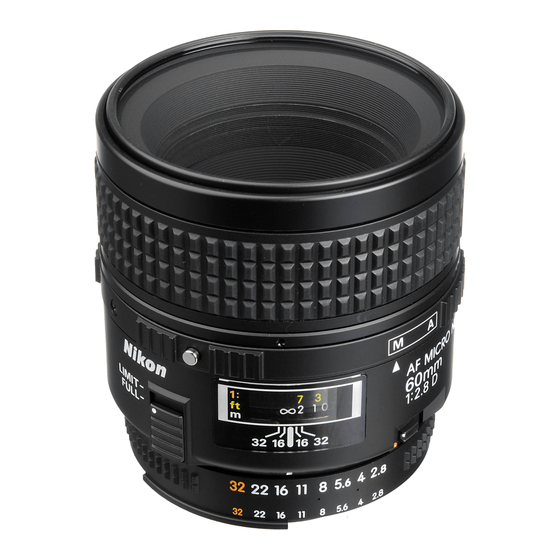Nikon AF Micro-Nikkor 60mm F/2.8 D Інструкція з експлуатації - Сторінка 4
Переглянути онлайн або завантажити pdf Інструкція з експлуатації для Об'єктив камери Nikon AF Micro-Nikkor 60mm F/2.8 D. Nikon AF Micro-Nikkor 60mm F/2.8 D 9 сторінок.
Також для Nikon AF Micro-Nikkor 60mm F/2.8 D: Посібник користувача (23 сторінок)

"
Screen
~B C 0
E GI G2 G3 G4 HI H2 H3 H4 J KIF M R T U F
Camera
"
F4 + DP-20
@
@
@
@@
F4 + DA-20
@
@
@
@@
F3
@@
@O
0
@@
6@
Presetting
focus range
~
in cases when you want to shoot within a specified distance range, you can
reduce focusing time by setting the focus limit switch from FULL position to
LIMIT. (There are two focusing limit zones; approx. a.3m [1 ft.] to infinity for
normal shooting, approx. a.3m [1 ft.] to a.219m
[83/4
in.] for shooting at a
close distance.)
Focusing
at a predetermined
reproduction
ratio
The reproduction
ratio is the relation between the size of the image
recorded on film and the actual subject size. If, for example, the Image on
the focusing screen is one. fifth the actual subject size, the reproduction
ratio is 1: 5.
To photograph at a predetermined
reproduction
ratio, use the following
procedure:
1. Manually turn the focus ring until the desired reproduction scale number
is aligned with the distance index.
2. Aim at the subject, then change your position, moving closer to or farther
away from the subject, until the image in the viewfinder sharpens.
To obtain the appropriate reproduction
ratio for each focal distance, see the
table on page 37.
Recommended Focusing Screens
Various interchangeable
focusing screens are available for Nikon cameras
to suit any type of lens or picture-taking
situation. Those which are
recommended
for use with your lens are listed.
@= Excellent focusing
0=
Acceptable focusing
Slight vignetting or moire phenomenon
affects screen image, but film
image shows no traces of this.
D.=Acceptable
focusing
The in-focus image in the central circular area may prove to be slightly
out of focus on the film. Focus on the surrounding matte area.
Blank box means not applicable. Since type M screen can be used for both
macrophotography
at a 1:1 magnification
ratio and for photomicrography,
it
has different applications than other screens.
For the K2, B2 and E2 focusing screens, refer to the columns on the K, B
and E screens, respectively. For details, also refer to the specific camera's
instruction manual.
Depth of Field
The depth of field indicator lines are engraved beside the distance index
line. At close distances, however, so little is in focus that it may be more
useful to check the depth of field table (on page 37). If your camera has a
depth of field preview button or depth of field preview lever, you can check
the depth of field in the viewfinder.
Minimum Aperture Lock (lilust. A)
For programmed
auto or shutter-priority
auto exposure shooting, use the
minimum aperture lock lever to lock the lens aperture at 1/32.
1. Set the lens to its minimum aperture (1/32).
2. Slide the lock lever in the direction of the aperture ring so the white dot
on the lever aligns with the orange dot.
To release the lock, slide the lever in reverse direction.
9'
